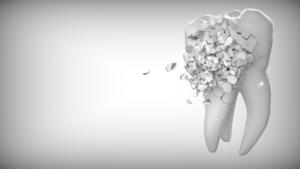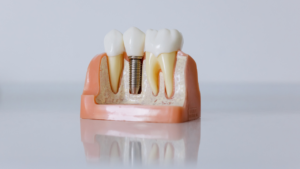A tooth fracture can occur due to trauma, biting on hard objects, or underlying dental issues. Whether it’s a small chip or a severe break, a fractured tooth can cause pain, sensitivity, and even lead to infections if left untreated. Understanding the causes, symptoms, and treatment options for tooth fractures is essential for maintaining good oral health. In this comprehensive guide, we’ll explore everything you need to know about tooth fractures and how to prevent them.
What is a Tooth Fracture?
A tooth fracture refers to any crack, split, or break in a tooth. It can range from minor surface cracks (craze lines) to complete breaks exposing the inner pulp. The severity of the fracture determines the treatment approach, which can vary from simple bonding to tooth extraction in extreme cases.

Common Causes of Tooth Fracture
Tooth fractures can happen for various reasons, including:

- Biting on Hard Foods – Chewing ice, hard candy, or unpopped popcorn kernels can cause teeth to crack.
- Trauma or Injury – Accidents, falls, or sports injuries can lead to tooth fractures.
- Teeth Grinding (Bruxism) – Excessive grinding weakens teeth, making them more prone to cracks.
- Large Fillings or Dental Work – Extensive fillings or weakened teeth from root canals may be more susceptible to fractures.
- Age and Wear – Teeth naturally weaken over time due to years of chewing and grinding.
- Sudden Temperature Changes – Consuming very hot food and immediately drinking something cold can cause thermal stress on teeth, leading to cracks.
Types of Tooth Fractures
There are several types of tooth fractures, each requiring different treatments:
1. Craze Lines
- Small, shallow cracks on the enamel.
- Usually painless and cosmetic in nature.
- No treatment needed, but whitening or bonding may help improve appearance.
2. Fractured Cusp
- Occurs when a part of the chewing surface of the tooth breaks off.
- Typically painless but may require a dental crown.
3. Cracked Tooth
- A crack that extends from the chewing surface toward the root.
- Can cause pain when chewing, especially when pressure is released.
- Early treatment with bonding or a crown can save the tooth; if untreated, a root canal may be necessary.
4. Split Tooth
- A deep crack that divides the tooth into two separate sections.
- Often results from an untreated cracked tooth.
- May require extraction if the damage is severe.
5. Vertical Root Fracture
- A crack that starts at the root and moves upward.
- May not be visible but can cause gum swelling and infection.
- Usually requires extraction or endodontic surgery.
Symptoms of a Fractured Tooth
Tooth fractures may not always be visible, but symptoms include:

- Pain when biting or chewing
- Sensitivity to hot, cold, or sweet foods
- Swelling around the affected tooth
- A sharp edge or rough feeling on the tooth
- Occasional pain that comes and goes
Treatment Options for Tooth Fractures
The treatment for a tooth fracture depends on its severity. Here are the most common solutions:

1. Dental Bonding
- Used for minor cracks and chipped teeth.
- A tooth-colored resin is applied and hardened with a special light.
2. Dental Crown
- For moderate fractures that weaken the tooth structure.
- A custom-made cap is placed over the tooth for protection.
3. Root Canal Therapy
- If the fracture reaches the pulp (inner nerve), a root canal is necessary.
- The infected pulp is removed, and the tooth is sealed and restored with a crown.
4. Tooth Extraction
- If the tooth is severely damaged and cannot be saved.
- A dental implant or bridge can replace the missing tooth.
5. Veneers for Cosmetic Repair
- Thin shells placed over the front of a chipped or cracked tooth.
- Provides a natural appearance and prevents further damage.
How to Prevent Tooth Fractures
To reduce the risk of a tooth fracture, follow these preventive measures:
- Avoid Chewing Hard Foods – Be cautious with nuts, hard candies, and ice.
- Wear a Mouthguard – If you play contact sports or grind your teeth at night, a custom-fitted mouthguard can help.
- Maintain Good Oral Hygiene – Regular brushing, flossing, and dental checkups keep teeth strong and healthy.
- Don’t Use Teeth as Tools – Avoid opening packages or biting nails with your teeth.
- Address Bruxism (Teeth Grinding) – If you grind your teeth, a nightguard can prevent excessive wear and fractures.
FAQs About Tooth Fractures
1. Can a fractured tooth heal on its own?
No, a fractured tooth does not heal by itself. Professional dental treatment is required to repair or protect the tooth from further damage.
2. How much does it cost to fix a fractured tooth?
The cost depends on the treatment. Bonding costs around $100-$400, while crowns range from $800-$2,500. Root canals can cost $700-$1,500, and extractions followed by implants can cost $3,000 or more.
3. Can I eat with a fractured tooth?
It’s best to avoid chewing on the affected side and stick to soft foods until you see a dentist.
4. What happens if a tooth fracture is left untreated?
An untreated fracture can worsen, leading to pain, infection, or even tooth loss. Seeking early treatment prevents complications.
5. Is a cracked tooth always painful?
Not always. Some cracks cause no symptoms, while others result in sensitivity or sharp pain when chewing.
Conclusion
A tooth fracture can range from minor cosmetic damage to severe structural issues requiring immediate treatment. Recognizing the symptoms early and seeking professional dental care can prevent further complications. Whether it’s a simple bonding procedure or a more complex root canal, timely intervention can save your tooth and maintain your oral health.

